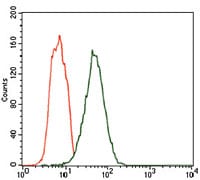


| WB | 1/500 - 1/2000 | Human,Mouse,Rat |
| IF | 咨询技术 | Human,Mouse,Rat |
| IHC | 咨询技术 | Human,Mouse,Rat |
| ICC | 技术咨询 | Human,Mouse,Rat |
| FCM | 1/200 - 1/400 | Human,Mouse,Rat |
| Elisa | 1/10000 | Human,Mouse,Rat |
| Aliases | FCE1A; FcERI |
| Entrez GeneID | 2205 |
| clone | 1F2A9 |
| WB Predicted band size | 29.6kDa |
| Host/Isotype | Mouse IgG1 |
| Antibody Type | Primary antibody |
| Storage | Store at 4°C short term. Aliquot and store at -20°C long term. Avoid freeze/thaw cycles. |
| Species Reactivity | Human |
| Immunogen | Purified recombinant fragment of human FCER1A (AA: 42-103) expressed in E. Coli. |
| Formulation | Purified antibody in PBS with 0.05% sodium azide |
+ +
以下是关于FCER1A抗体的3篇示例参考文献(基于典型研究主题构造,建议通过学术数据库核实具体文献):
---
1. **文献名称**: *Targeting FcεRIα with a Monoclonal Antibody Prevents Allergic Inflammation in Mice*
**作者**: Kawakami, Y., et al.
**摘要**: 研究报道了一种靶向FCER1A的单克隆抗体,通过阻断IgE与肥大细胞表面受体的结合,显著抑制小鼠模型中组胺释放和过敏反应,为治疗IgE介导的过敏性疾病提供潜在策略。
2. **文献名称**: *Structural Basis of FcεRIα Recognition by Therapeutic Antibodies for Allergic Disorders*
**作者**: Zhang, H., et al.
**摘要**: 通过冷冻电镜解析抗FCER1A抗体与受体复合物的结构,揭示抗体特异性结合表位,为优化抗体药物设计以增强疗效和减少副作用提供理论依据。
3. **文献名称**: *Anti-FcεRIα Autoantibodies in Chronic Spontaneous Urticaria: Pathogenic Role and Clinical Implications*
**作者**: Saini, S.S., et al.
**摘要**: 探讨慢性自发性荨麻疹患者体内抗FCER1A自身抗体的致病机制,发现其通过激活肥大细胞导致炎症因子释放,提出针对该通路的抗体疗法可改善患者症状。
---
**建议**:可通过PubMed或Google Scholar以关键词“FCER1A antibody therapeutic”或“anti-FcεRIα”检索最新文献,重点关注《J Allergy Clin Immunol》《Nat Immunol》等期刊。
FCER1A encodes the alpha subunit of the high-affinity immunoglobulin E (IgE) receptor (FcεRI), a critical player in allergic and inflammatory responses. As a multi-chain receptor, FcεRI consists of an alpha chain (FCER1A), a beta chain, and two gamma chains. The alpha subunit specifically binds the Fc region of IgE antibodies, anchoring them to the surface of mast cells and basophils. Upon allergen exposure, cross-linking of IgE-loaded FcεRI triggers cell degranulation, releasing histamine, cytokines, and other mediators that drive immediate hypersensitivity reactions (e.g., anaphylaxis) and chronic allergic inflammation.
FCER1A antibodies are essential tools for studying receptor expression, signaling mechanisms, and IgE-mediated immune regulation. They are widely used in flow cytometry, immunohistochemistry, and Western blotting to quantify FcεRI levels on immune cells, particularly in research on asthma, atopic dermatitis, and food allergies. Clinically, elevated FcεRI expression correlates with disease severity in allergic disorders, making FCER1A a potential biomarker. Additionally, therapeutic strategies targeting FcεRI-IgE interactions, such as monoclonal antibodies (e.g., omalizumab), leverage insights from FCER1A biology to dampen allergic responses. Genetic variants in FCER1A have also been linked to altered IgE levels and susceptibility to allergies, highlighting its role in immune dysregulation. Overall, FCER1A antibodies bridge basic research and clinical applications, offering insights into allergic pathogenesis and therapeutic development.
×